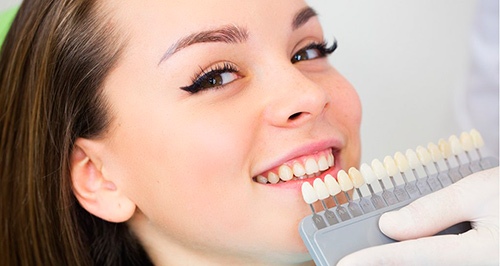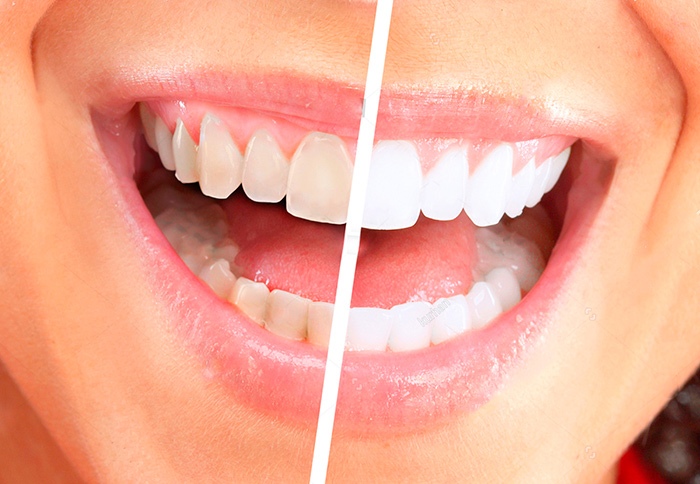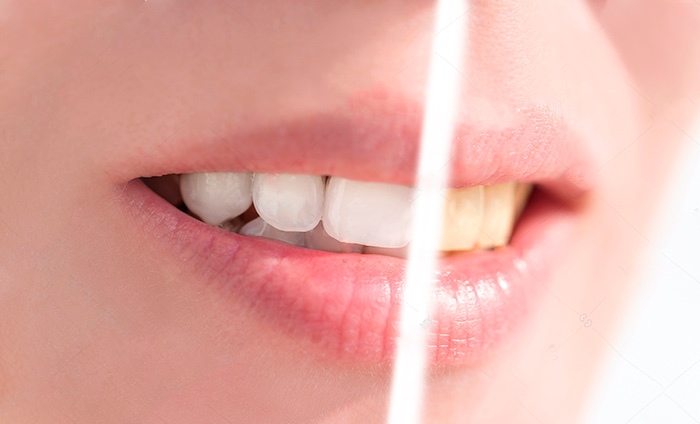Professional teeth whitening
Today, the teeth whitening procedure in dental offices has gained a fairly high level of popularity.

Despite the fact that the normal color of teeth is yellowish-white, a clean, snow-white smile is a kind of magnet for people around you. Absolutely healthy teeth are usually grayish or yellowish in color. Constant intake of food, drinks, etc. causes darkening of the enamel. To restore the attractiveness of your teeth, you can use the modern capabilities of dental offices.
What kind of procedure is teeth whitening?
Teeth whitening is a chemical procedure that is often confused with "lightening". In fact, these are completely different processes. Whitening is a mechanical effect on the tooth enamel using various specialized instruments. Teeth whitening involves the use of various compositions and products to obtain a perfectly white color. This is the main difference from the lightening, during which the tooth shade becomes natural. Also, unlike lightening, the effect of teeth whitening lasts for a very long time.
There are several methods and ways to carry out this procedure. They can be divided into two categories:
- gentle ways;
- effective ways.
Gentle methods of tooth enamel whitening are as follows: the dentist prescribes a product for the patient, which he uses independently at home for several days. However, it is the effective methods that are considered the best. Such procedures are performed in dentists' offices. The doctor completely isolates the oral mucosa and applies a chemical agent to the teeth. The procedure is repeated several times. The specific number of approaches depends on the individual characteristics of the patient's teeth, the desired color and the general condition of the enamel.
Teeth whitening in dentistry
Most people who want to turn their teeth white have certain questions. The most popular of them is "how is teeth whitening done in dentistry".

Today, there are many different methods of teeth whitening. Each of them has its pros and cons. Therefore, this question does not have an unambiguous answer, because depending on the chosen method, the stages of the whitening procedure can differ dramatically. Conventionally, all methods can be divided into two categories: professional and non-professional.
Undoubtedly, the most effective methods are those that are considered professional. Only with their help can you carry out absolutely safe teeth whitening in dentistry and get a guaranteed result. There are many such methods, and the following types can be distinguished separately:
- Photopolymerization;
- Using different chemical compositions;
- Laser;
- Endo, etc.
Each technique is unique in its own way and has a certain set of advantages and disadvantages.
The second category includes all the methods of teeth whitening that you can do yourself at home. Various plates, pencils, gels, etc. Obviously, professional teeth whitening at the dentist beats home methods in all respects. Perhaps the only advantage of non-professional methods is their availability and low price.
How teeth whitening is done in dentistry "Oleksiuk"
Before deciding on the method of teeth whitening, it is imperative to have a consultation in a professional dental office. The doctor will conduct an examination and, taking into account your individual characteristics of your teeth, will choose the most optimal method. Immediately before starting the whitening process, a dental hygienist should perform a professional cleaning of the oral cavity and enamel.

Photopolymerization whitening is performed by using a specialized concentration gel that is heated. On average, it takes several treatments to achieve a completely white color. In addition to whitening with photopolymer systems, other methods of professional teeth whitening are often used in Oleksiuk dentistry, which are worth considering in more detail.
Teeth whitening methods
As already mentioned, in addition to the most popular method of teeth whitening using photopolymerization, other methods are often used, including:
- Chemical teeth whitening;
- Cold teeth whitening;
- Complex teeth whitening;
- Intracanal teeth whitening.
Chemical bleaching
Almost all professional teeth whitening methods in dental offices can be characterized as chemical, due to the fact that they involve the use of a special gel that affects dentin rather than enamel. The main components of this substance are hydrogen and carambite. The only difference between the subtypes of chemical teeth whitening is the equipment used.
Cold bleaching
The cold bleaching technique belongs to the category of photobleaching systems, the principle of its use is to use a specialized gel in combination with cold light radiation used as a catalyst. Most often, its source is blue or blue halogen lamps. Such equipment is able to operate without generating heat.
Complex whitening
Complex whitening is the use of several techniques to achieve the best possible result. The choice of a specific set of products and equipment depends on the individual characteristics of the patient's tooth enamel.
Intracanal teeth whitening
Intracanal teeth whitening is significantly different from all the methods described above. This method is also called endo-whitening, which means whitening the tooth from the inside. The procedure is as follows:
- Immediately before the procedure, professional chemical cleaning of the oral cavity and tooth enamel is performed.
- Next, a special gel is injected into the previously depulpated cavity of the dental crown. Its main component is sodium perbonate.
- A temporary filling is placed on top of the tooth for the duration of treatment.
- After a certain period of time (assigned individually for each patient), the dentist conducts an examination and, if the desired result is achieved, replaces the temporary filling with a permanent one.
This method of teeth whitening is used when the enamel is significantly darkened. Intracanal tooth whitening allows you to achieve a white color in a fairly short period of time, and the effect of the procedure lasts longer compared to alternative whitening methods, since the tooth enamel is colored from the inside of the tooth.
Types of teeth whitening
Virtually any of the methods described above, except for in-channel, can be used with various special tools, which include:
- teeth whitening gel;
- toothpaste for teeth whitening;
- mouthguards for teeth whitening;
- tooth powder for teeth whitening.
Gel teeth whitening
There are many different teeth whitening gels available. In most cases, hydrogen peroxide is a part of each of them. It is this substance that allows you to eliminate stains on tooth enamel that remain there from coffee, food, drinks, etc. Even after the first gel whitening procedure, the result is visible, but to achieve maximum results, you need to use the gel several times. Depending on the specific gel used, the peroxide content in its composition can vary from 4 to 7.5 percent. Less commonly, the composition of whitening gels is based on 10-15 percent carambide peroxide. It works identically to the first option.
The main difference is the gentler whitening mode, but it is impossible to achieve a snow-white color with such gels.
Tooth whitening paste
The principle of whitening pastes is based on the content of abrasive particles. Active substances affect the tooth enamel and lighten it during the course of use. The particles can be in the form of hydrogen peroxide, silicon oxide, dicalcium phosphate, etc. Unfortunately, this way you can achieve a maximum of three shades of lightening. Teeth whitening powder works in a similar way.
Teeth whitening with trays.
Teeth whitening trays contain the same active ingredients as the above products. There are several varieties:
- Regular - these mouth guards are produced in large quantities. Wearing this type of mouthguard is not entirely comfortable, as the size of each person's teeth is different. A standard set includes ten mouthguards. They are used during one course of treatment.
- Thermoplastic mouth guards. Their main difference from conventional slippers is that they are made of materials that soften when heated. This allows absolutely anyone to wear them comfortably. It is enough to briefly place the mouthguard in boiling water before use and then put it on your teeth. The soft material will take the desired shape and then harden.
- Individual - as the name implies, these aligners are created individually for each patient. To do this, a 3D scan is taken of the patient's teeth, and a set is created accordingly.
Teeth whitening contraindications
Before heading to the dental office for teeth whitening, you need to carefully weigh the pros and cons. There are a number of contraindications in which it is highly discouraged to undergo the procedure described.
- Large size of the pulp chamber. If this feature of the structure of the teeth is pronounced, then whitening is impossible due to high sensitivity. Most often, this contraindication is observed in children and adolescents. When a person grows up, the chamber shrinks and becomes normal in size.
- Increased level of tooth sensitivity.
- Various diseases of tooth enamel.
- It is not recommended for pregnant women to use the procedure described above.
- A large number of prostheses (fillings, crowns, pins, etc.).
- Low pain threshold.
- Diseases of the circulatory system and heart.
In most cases, the effects of teeth whitening are reversible. However, the procedure can cause the manifestation of various diseases of the oral cavity, gums and teeth, so before whitening your teeth, you need to undergo an examination by a professional dentist.
Whitening of crooked and dead teeth
The procedure of whitening dead teeth is carried out quite often. In fact, the procedure involves the simultaneous use of any available method of enamel whitening and the injection of an active substance into the tooth structure. However, most dentists do not practice this procedure, as it can cause complications in the form of manifestations of diseases of neighboring teeth and gums.
Very often, patients ask the question "can crooked teeth be whitened?", and the answer is "yes". Exception: if you plan to straighten your teeth in the next year, it is better to lighten your teeth after straightening. Of course, nothing prevents you from going through the procedures in the reverse order, but in this case, the whitening effect will disappear very quickly.
Sensitivity of teeth after whitening
Usually, after undergoing a whitening procedure, the patient is concerned about pain. This is due to the increased sensitivity of the tooth due to the components contained in whitening products. To alleviate the situation, you should follow the following recommendations.
After teeth whitening, you need to follow a special diet. Otherwise, the effect of the procedure will disappear very quickly. A "white" diet, which includes light-colored foods, should be followed for at least two weeks after the procedure.
What can you eat after teeth whitening?
The list of allowed products includes:
- fish and other seafood;
- milk;
- white meat (chicken, rabbit, etc.);
- light-colored fruits and vegetables;
- cereals (preferably rice);
- nuts;
- mushrooms.
This diet is aimed at eliminating not only certain types of foods, but also the use of coffee drinks, bad habits (smoking, alcohol consumption, etc.). To accelerate the enamel restoration procedure, it is recommended to consume foods high in fluoride and calcium.
Many patients, before visiting the dentist, are interested in the question "what should not be eaten after teeth whitening?". This list includes foods:
- containing a large amount of acids (citrus fruits, sour berries, etc.);
- chocolate;
- brightly colored fruits and vegetables;
- any beverages that contain caffeine;
- products containing alcohol;
- carbonated beverages.
Below are answers to the most popular questions dentists hear about teeth whitening procedures
Which whitening method is better?
There is no definite answer to this question, since the result of the whitening procedure depends not only on the method and substance used, but also on the individual characteristics of the patient's tooth enamel and its general condition. Many dentists recommend endo-whitening, but in any case, before choosing a technique, each person should consult a specialist.
How often can teeth whitening be done?
Professional teeth whitening in dental offices is highly discouraged more than once a year. Home methods can be used about once every six months.
How much teeth whitening is enough?
The period of preservation of a snow-white smile depends not only on the method of tooth enamel treatment, but, to a greater extent, on the patient's compliance with all the recommendations and diet offered to him. In this case, perfectly white teeth will delight you for at least six months.
Is teeth whitening harmful?
There is no definitive answer to this question. Of course, the effect of chemicals on tooth enamel cannot have a positive effect on its condition, but it does not cause significant harm either.
Does it hurt to whiten teeth?
When using modern whitening techniques, this procedure is absolutely painless for the patient. Within a few days after the procedure, the patient may experience discomfort and slight pain. This is due to the increased sensitivity of the enamel.
Teeth hurt after whitening, what to do?
If you feel discomfort and pain after a visit to the dentist, it is recommended to take a painkiller and go to bed. You can also use a cool compress on your cheeks to help soothe the pain.
How much does teeth whitening cost?
Despite the fact that the procedure of teeth whitening with the help of specialized components has gained popularity relatively recently, its cost is quite affordable. Home whitening methods are much cheaper, but their effect is not as strong. You can find out more about the prices for teeth whitening services in the "Prices" section or by calling us.
To find out the prices for treatment in your case, dial the number:
(0352) 40 00 08 or (098) 130 13 71
Sign up for a free consultation.